tow PONTIAC GRAND AM 1998 User Guide
[x] Cancel search | Manufacturer: PONTIAC, Model Year: 1998, Model line: GRAND AM, Model: PONTIAC GRAND AM 1998Pages: 370, PDF Size: 16.11 MB
Page 84 of 370

AUTOMATIC OVERDRIVE (D): This position is for
normal driving with the four-speed automatic transaxle.
If you need more power for passing,
and you’re:
Going less than about 35 mph (55 km/h), push your
0 Going about 35 mph (55 km/h) or more, push the
The transaxle will automatically shift down to the next
gear and provide more power. accelerator pedal about halfway down.
accelerator all the way down.
NOTICE:
This NOTICE applies only if you have an
automatic overdrive transaxle. If your vehicle is
so equipped and if it seems to start up rather
slowly,
or if it seems not to shift gears as you go
faster, something may be wrong with a transaxle
system sensor.
If you drive very far that way,
your vehicle can be damaged. So, if this happens,
have your vehicle serviced right away. Until then,
you can use SECOND
(2) when you are driving
less than
35 mph (56 km/h) and AUTOMATIC
OVERDRIVE (0) for higher speeds. THIRD
(3): This
position is also used for normal
driving, however, it offers more power and lower fuel
economy than AUTOMATIC
OVERDRIVE (D). Here
are some times you might choose THIRD (3) instead of
AUTOMATIC
OVERDRIVE (D):
When driving on hilly, winding roads.
0 When towing a trailer, so there is less shifting
between gears.
0 When going down a steep hill.
SECOND
(2): This position gives you more power but
lower fuel economy. You can use
SECOND (2) on hills.
It can help control your speed
as you go down steep
mountain roads, but then you would also want
to use
your brakes off and on.
2-23
Page 88 of 370

Parking Brake
To set the parking brake, hold the regular brake pedal
down
with your right foot. Pull up on the parking brake
handle. If the ignition is on, the brake system warning
light will come on.
To release the parking brake, hold the regular brake
pedal down. Pull the parking brake lever up until you
can press the release button. Hold the release button in as you move the brake lever all the way down.
Driving with the parking brake on can cause
your rear brakes to overheat. You may have to replace them, and you could also damage other
parts
of your vehicle.
If you are towing a trailer and are parking on any hill,
see “Towing a Trailer” in the Index. That section shows
what to do first to keep the trailer from moving.
2-27
Page 89 of 370
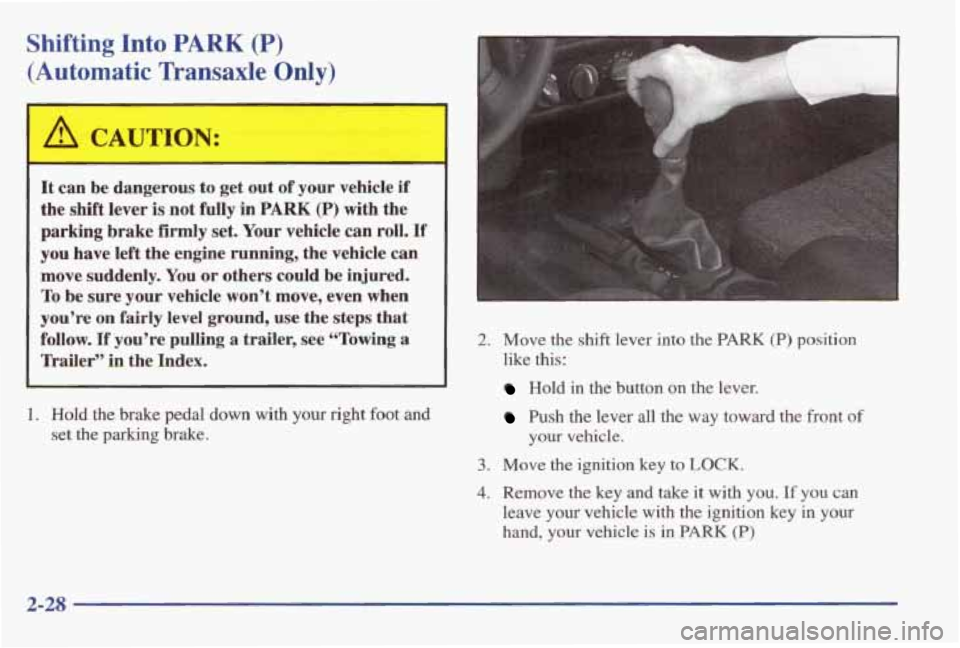
Shifting Into PARK (P)
(Automatic Transaxle Only)
A CAUTION:
It can be dangerous to get out of your vehicle if
the shift lever is not fully in PARK (P) with the
parking brake firmly set. Your vehicle can
roll. If
you have left the engine running, the vehicle can
move suddenly. You or others could
be injured.
To be sure your vehicle won't move, even when
you're on
fairly level ground, use the steps that
follow.
If you're pulling a trailer, see "Towing a
Tkailer" in the Index.
i
1. Hold the brake pedal down with your right foot and
set the parking brake.
2. Move the shift lever into the PARK (P) position
like this:
Hold in the button on the lever.
Push the lever all the way toward the front of
your
vehicle.
3. Move the ignition key to LOCK.
4. Remove the key and take it with you. If you can
leave your vehicle with the ignition key in your
hand, your vehicle is in
PARK (P)
2-28
Page 91 of 370
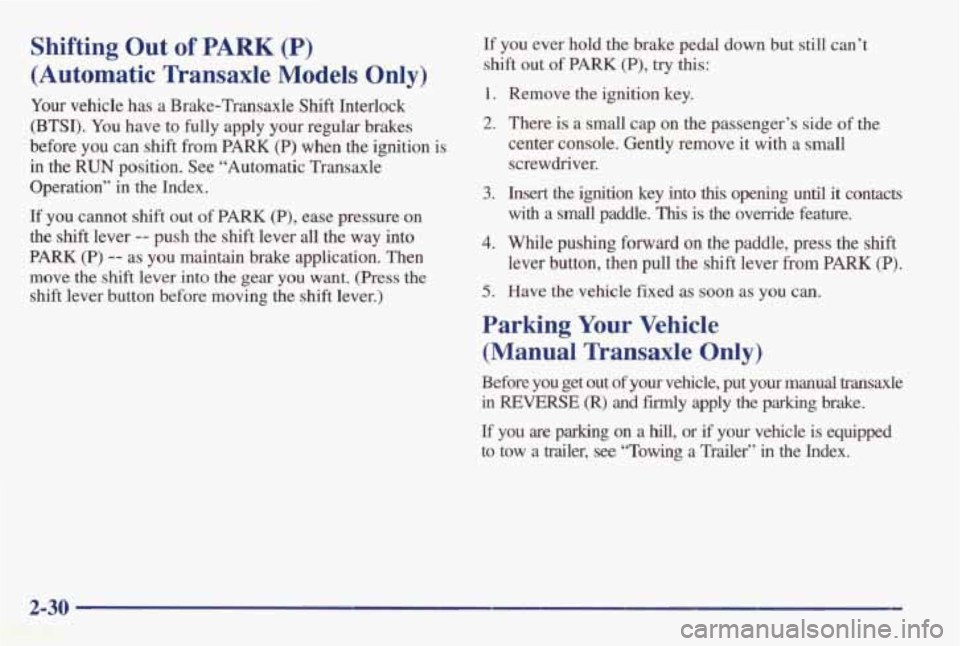
Shifting Out of PARK (P)
(Automatic Transaxle Models Only)
Your vehicle has a Brake-Transaxle Shift Interlock
(BTSI). You have to
fully apply your regular brakes
before you can shift from PARK
(P) when the ignition is
in the
RUN position. See “Automatic Transaxle
Operation” in the Index.
If you cannot shift out of PARK (P), ease pressure on
the
shift lever -- push the shift lever all the way into
PARK (P) -- as you maintain brake application. Then
move the shift lever into the gear you want. (Press the
shift lever button before moving the shift lever.) If you
ever hold the brake pedal down
but still can’t
shift out of
PARK (P), try this:
1. Remove the ignition key.
2. There is a small cap on the passenger’s side of the
center console. Gently remove it
with a small
screwdriver.
3. Insert the ignition key into this opening until it contacts
with a small paddle. This is the override feature.
4. While pushing forward on the paddle, press the shift
lever button, then pull the shift lever from PARK (P).
5. Have the vehicle fixed as soon as you can.
Parking Your Vehicle
(Manual Transaxle Only)
Before you get out of your vehicle, put your manual transaxle
in REVERSE (R) and firmly apply the parking brake.
If you are parking on a hill, or if your vehicle is equipped
to tow a trailer, see “Towing a Trailer’’ in the Index.
2-30
Page 93 of 370
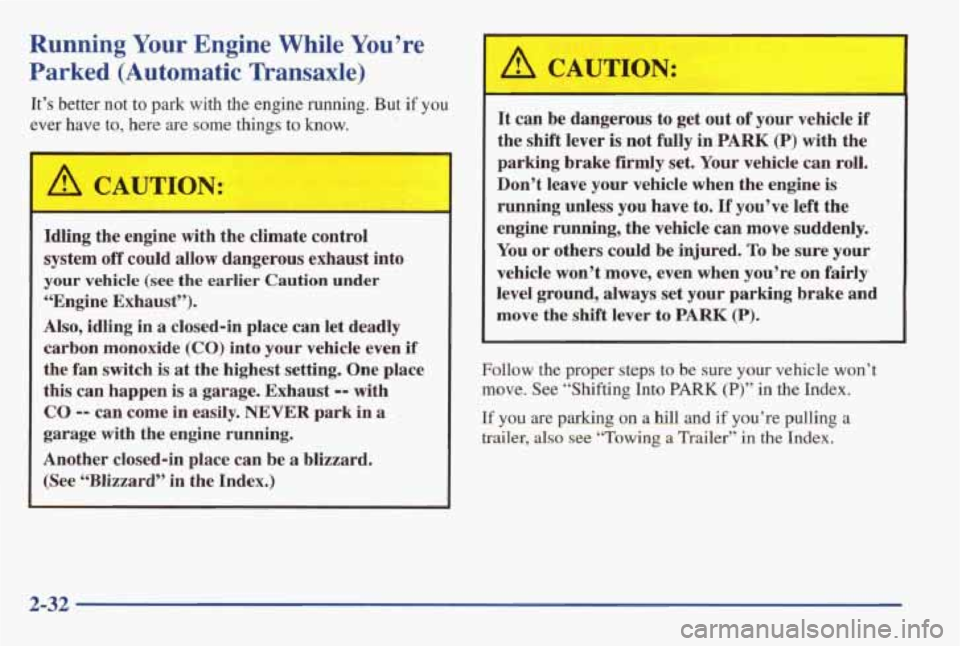
Running Your Engine While You’re
Parked (Automatic Transaxle)
It’s better not to park with the engine running. But if you
ever have to, here are some things to know.
I-
A CAUTION:
-
Idling the engine with the climate control
system
off could allow dangerous exhaust into
your vehicle (see the earlier Caution under
“Engine Exhaust”).
Also, idling in
a closed-in place can let deadly
carbon monoxide
(CO) into your vehicle even if
the fan switch is at the highest setting. One place
this can happen is a garage. Exhaust -- with
CO -- can come in easily. NEVER park in a .
garage with the engine running.
Another closed-in place can be
a blizzard.
(See “Blizzard” in the Index.)
A CAUTION:
-1
It can be dangerous to get out of your vehicle if
the shift lever is not fully in PARK (P) with the
parking brake firmly
set. Your vehicle can roll.
Don’t leave your vehicle when the engine
is
running unless you have to. If you’ve left the
engine running, the vehicle can move suddenly.
You
or others could be injured. To be sure your
vehicle won’t move, even when you’re
on fairly
level ground, always set your parking brake and
move the shift lever
to PARK (P).
Follow the proper steps to be sure your vehicle won’t
move. See “Shifting Into
PARK (P)” in the Index.
If you are parking on a hill and if you’re pulling a
trailer,
also see “Towing a Trailer” in the Index.
2-32
Page 96 of 370
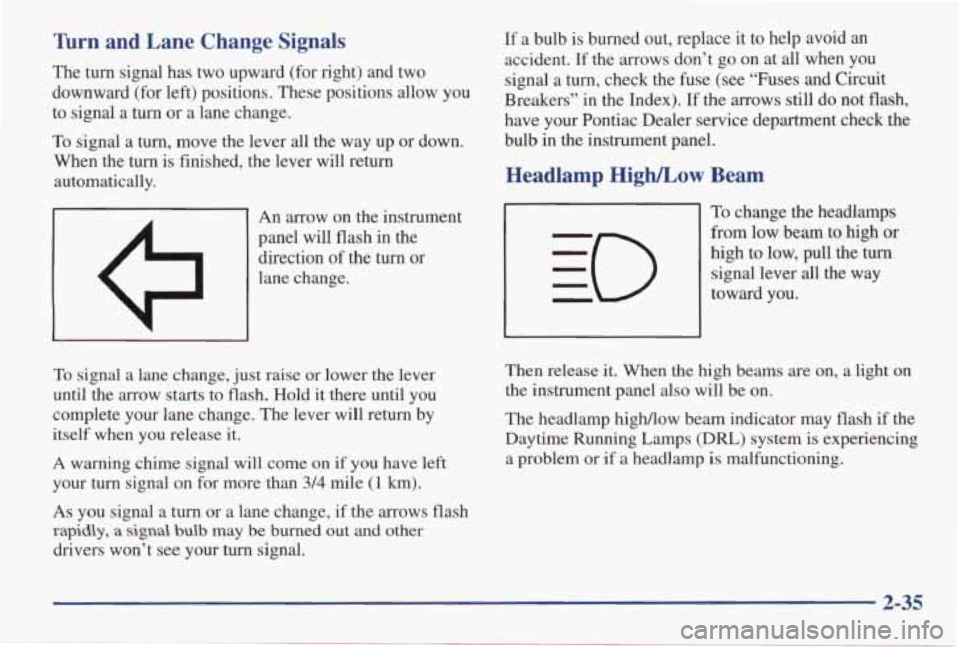
’hrn and Lane Change Signals
The turn signal has two upward (for right) and two
downward (for left) positions. These positions allow you
to signal a turn
or a lane change.
To signal a turn, move the lever all the way up or down.
When the turn is finished, the lever will return
automatically.
An arrow on the instrument
panel will flash in the direction of the turn
or
lane change.
To signal a lane change, just raise or lower the lever
until the arrow starts to flash. Hold
it there until you
complete your lane change. The lever will return by
itself when you release it.
A warning chime signal will come on if you have left
your turn signal on for more than 3/4 mile
(1 km).
As you signal a turn or a lane change, if the arrows flash
rapidly, a signal bulb may be burned out and other
drivers won’t see your turn signal. If
a bulb is burned out, replace it to help avoid an
accident. If the arrows don’t
go on at all when you
signal a turn, check the fuse (see “Fuses
and Circuit
Breakers’’ in the Index).
If the arrows still do not flash,
have your Pontiac Dealer service department check
the
bulb in the instrument panel.
Headlamp Highhow Beam
To change the headlamps
from low beam to high
or
high to low, pull the turn
signal lever all the way
toward
you.
Then release it. When the high beams are on, a light on
the instrument panel also will be on.
The headlamp higMow beam indicator may flash if the
Daytime Running Lamps
(Dm) system is experiencing
a problem or
if a headlamp is malfunctioning.
2-35
Page 98 of 370
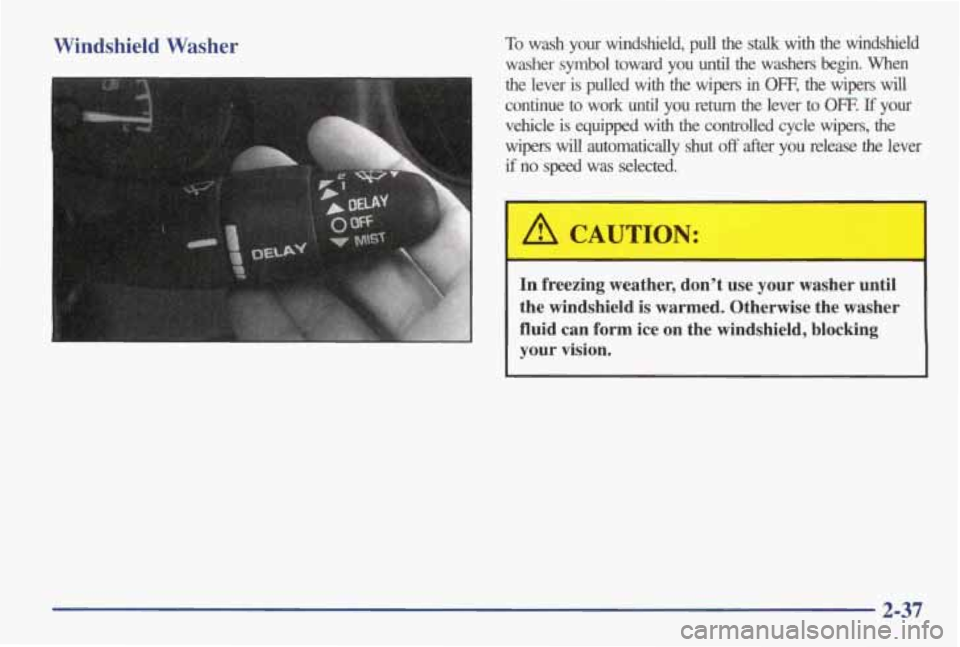
Windshield Washer To wash your windshield, pull the stalk with the windshield
washer symbol toward you until the washers
begin. When
the lever is pulled with the wipers in Om, the wipers will
continue to work until you return the lever to OFF. If your
vehicle
is equipped with the controlled cycle wipers, the
wipers will automatically shut off after you release the lever
if no speed was selected.
A CAUTION:
I
In freezing weather, don’t use your washer until
the windshield is warmed. Otherwise the washer
fluid can form ice on the windshield, blocking
your vision.
2-37
Page 108 of 370

Mirrors
Convex Outside Mirror
Your passenger’s side mirror is convex. A convex
mirror’s surface
is curved so you can see more from the
driver’s seat.
Manual Remote Control Mirror
The outside rearview mirror should be adjusted so you
can just see the side of your vehicle when you
are sitting
in a comfortable driving position.
Adjust the driver’s side
outside mirror with the control lever on the
A CAUTION: I driver’s door.
A convex mirror can make things (like other
vehicles) look farther away than they really are.
If you cut too sharply into the right lane, you
could
hit a vehicle on your right. Check your
inside mirror or glance over your shoulder before
changing lanes.
To adjust your passenger’s side mirror, sit in the driver’s
Inside Daymight Rearview Mirror
To reduce glare from lights behind you, move the lever
toward you to the night position. seat
and have a passenger adjust the
mirror for you.
2-47
Page 109 of 370

Power Remote Control Mirror
(If Equipped)
This selector knob
controls both outside
rearview mirrors.
Storage Compartments
Glove Box
Use one of the vehicle’s keys to lock and unlock
the glove box.
To open, pull the glove box handle
toward you.
Center Console Storage Area
I I
Select the mirror you want to adjust by rotating the knob
to the left or right. Adjust each mirror
so that you can
just see the side of
your vehicle when you are sitting in a
comfortable driving position.
Turn the knob to the center to turn the remote control
mirror off.
The armrest opens into a storage area for cassette tapes,
gloves, etc.
To open it, lift up on the front portion of
the armrest.
2-48
Page 120 of 370
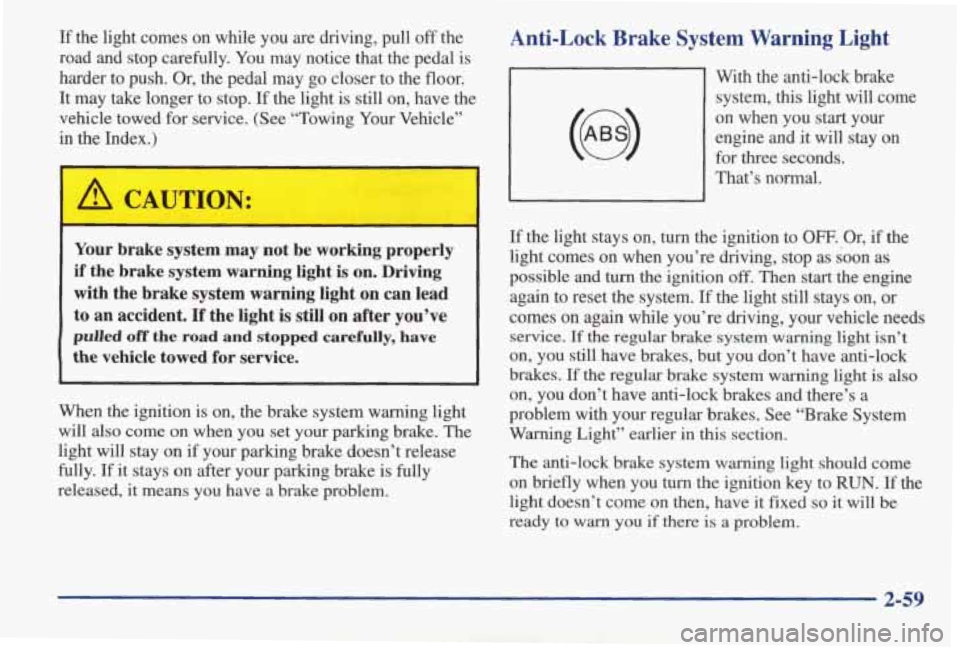
If the light comes on while you are driving, pull off the
road and stop carefully. You may notice that the pedal is
harder to push. Or, the pedal may
go closer to the floor.
It may take longer to stop. If the light
is still on, have the
vehicle towed for service. (See “Towing Your Vehicle”
in the Index.)
I A CAUTION:
Your brake system may not be working properly
if the brake system warning light is on. Driving
with the brake system warning light on can lead to an accident.
If the light is still on after you’ve
pulled off the road and stopped carefully, bqve
the vehicle towed for service.
When the ignition is on, the brake system warning light
will
also come on when you set your parking brake. The
light will stay on if your parking brake doesn’t release
fully.
If it stays on after your parking brake is fully
released, it means you have a brake problem.
Anti-Lock Brake System Warning Light
With the anti-lock brake
system,
this light will come
on when you
start your
engine
and it will stay on
for three seconds.
That’s normal.
If the light stays on, turn the ignition to OFF. Or, if the
light comes on when you’re driving, stop
as soon as
possible and turn the ignition off. Then start the engine
again to reset the system.
If the light still stays on, or
comes on
again while you’re driving, your vehicle needs
service. If the regular brake system warning light isn’t
on, you still have brakes, but you don’t have anti-lock
brakes.
If the regular brake system warning light is also
on, you don’t have anti-lock brakes and there’s a
problem with
your regular brakes. See “Brake System
Warning Light” earlier in this section.
The anti-lock brake system warning light should come
on briefly when you turn the ignition key to
RUN. If the
light doesn’t come on then, have it fixed
so it will be
ready
to warn you if there is a problem.
2-59